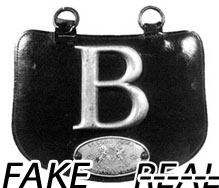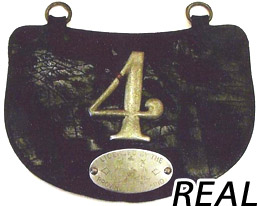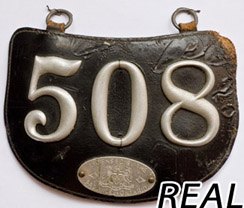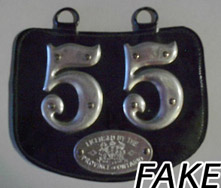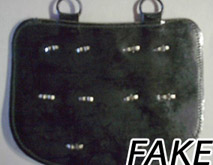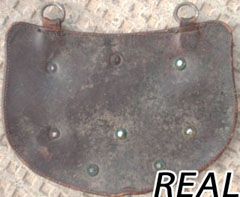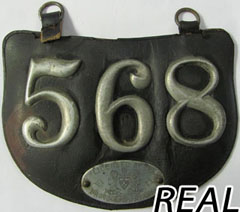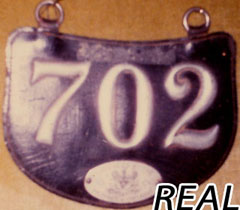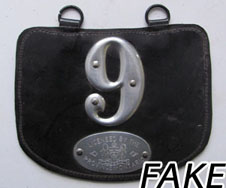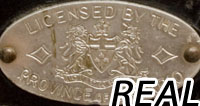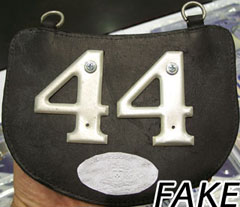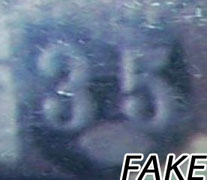The rarer a license plate is, the more likely that the example you find may be a fake. Some fakes can be real hatchet jobs that might have been innocently cobbled together to occupy an empty space on someone’s wall. Others can be dangerously deceiving, and it could take an expert, or sometimes a group of experts, to debunk a plate's presentation of authenticity.
As I wrote in the fall of 2011, most Ontario collectors don’t have to worry about this sort of thing—Ontario plates are fairly common to find, and they don’t really get hard to find unless you’re looking for a porcelain, or a rubber plate, although the fakes are significantly outnumbered by real examples. In Ontario, there is only one type of auto plate that could be outnumbered by fakes, and that’s the first-issue leather shield. With only a dozen estimated to survive, they’re rare enough that it could be worth someone’s while to go to the time and expense of trying to fabricate one that is real-looking enough to fool an expert. I have documented real and fake ones— and I’ve put together a collector’s guide of how to spot the difference. All plates here are shown approximately to scale.
Here is a summary of some of the real Ontario leather plates that are known to exist; I don’t know the numbers for all of them. Others may be out there—number 508 was not discovered until last year—but given that there are so few, this guide may be helpful, just in case you find one and are hopeful to determine whether it’s real or fake. All but two of these plates are shown throughout this article.
4 – In private collection, owned by descendant of original registrant.
9 - In MTO collection (a fake 9 is pictured, no photo available of the real one). 126 - In private collection. Portions of numbers missing. 209(?) - Status unknown, may have a broken number. No photo available. 508 – Discovered in 2012, currently in private collection. 568 – Previously in a collection, sold on eBay in 2011. 591 – Previously in a collection, sold privately in 2009. 702 – In private collection, used at some point as a template for making reproductions. 744 – Photographed in Ontario License Plates – A Century of History by Joseph P. Sallmen
Thanks to Joe Sallmen for contributing additional information and the image of 744.
These leather plates were made by sandwiching two shield shapes together back-to-back, so you should see the stitching around the periphery of the plate. Most known shields have three digits, and all those issued to privately owned autos are the same size, regardless of whether there are one or three digits in the serial number. Also, the leather straps that hold the mounting rings are also a uniform distance apart—none of the real ones have any variation in the location of these straps (they are fragile, though, and it’s possible that one or both could be missing from a real shield—but you should still be able to see stumps or scars where they were located, as they were fastened to the plate by inserting them in between the two sandwiched shield shapes before they were stitched together).
The Ontario government has, within its archives, a leather shield bearing the single letter “B”. Lettered plates would have been issued to auto dealers of the time. However, this shield appears to be more narrow than the known numbered examples-- in particular, the single-digit number 4 plate is significantly wider than the B plate, despite bearing only one digit. The B plate has long been featured in government publications as an example of a first-issue license plate, and as such, it has been presumed to be authentic. However, as noted collector Joe Sallmen has discovered, there was:
"a 1920 article in the Globe and Mail describing the short (then) history of Ontario plates. It went on to describe the collection the MTO has, which is very amazing that 90 years later they still have those plates. The B leather plate is one of them. Now, that article interestingly called it a replica, so that would explain the smaller size. I suspect they found original materials to make up the plate and that they did. It looks too nice to have actually been used. Of course since it was made up some time before 1920, that's too long ago to prove it was made up after the fact. So, I can only take the newspaper article's word for it."
Given this information, and the size discrepancy between this "B" plate and the known authentic examples, its authenticity could be debunked.
Fakes often have differences in the size of the leather shield, and often fail to reproduce the shape correctly. Pictures of the "B" plate have may have been used as a template for designing a number of fake plates of incorrect size. Some have straight edges down the sides, or they have differently-curved bottom edges. There’s no variation among the real ones, so if the shape is different, it’s a dead giveaway that you’re looking at a fake.
Another thing to realize is that these shields are made of leather that was new between 1903 and 1905. If the leather has survived to present times, it should be very dry—all moisture would have long since escaped—and the shields should be light for their size, and not at all flexible—if anything, they’ll be brittle and the mere thought of bending it with your hands could be enough to split it in half.
Newer fake shields, assuming they’re made of leather, would be made of a heavier material with more moisture, and would feel more substantial in-hand. Some leather plates, such as 508 above, have warped into a convex shape. Fakes are typically flat. Sometimes, the leather face itself may crack or develop an alligator-skin like crazing, not unlike that shown on number 591. Don’t expect a real leather shield to be unblemished. It’ll have marks, chewed corners, crazing, scratches, or other problems. If it looks new, it probably is.
One of the easiest ways to spot a fake Ontario shield is by looking at the cast aluminum numbers. They have rear-facing rivets that go through the leather. The face of the rivets on the rear side is round, although sometimes these rivets break off and the number may be held in place with wire, as is the case for the zero on number 508. If you don’t see any rivets at all on the rear side, or if you see fasteners that are not rivet style, be wary. The front of the numbers is easier to spot—if there are rivets or screws on the fronts of the aluminum numbers, the plate is fake, fake, fake. No real Ontario leather plate has front-riveted numbers. A common means of making leather fakes is by using aluminum numbers with mounting holes, like those shown on fake number 236. If you don't see the holes themselves, you might see screws or rivets covering the holes. Avoid them like the plague!
The cast aluminum numbers themselves are ornate and quite beautiful. They should not be have a highly polished finish. Not that they’re dull, but they shouldn’t look at lustrous as your stainless-steel fridge door. If you look at the curvature of the digits, and the thicker strokes versus the thin ones on each digit, you’ll see that they’re three-dimensional with raised edges. I don’t have a library of what each digit looks like, although I will try to build one if I can find more high-quality images of the rare leather plates that still exist. You can compare the digits between the real and fake plates shown here to get a better idea of how a real plate should look. There’s no way to make these numbers in the real style anymore, so fakes can only approximate them, and that’s their Achilles heel. I bought a homemade “fake kit” a few years ago to study, and the initial idea by the maker was to machine the numbers from flat slabs of aluminum, but this idea proved too difficult to execute. Instead, hardware-store-bought numbers were purchased for this kit (see numbers 236 above and 44 below-- it's the same slab of leather, just with different numbers posed atop).
Finally, all real Ontario leather shields have an oval-shaped emblem at the bottom, made of aluminum, engraved, and riveted onto the plate on each side. Unlike the numbers, these emblems do have front rivets; one is on the left and one is on the right. They should say “Licensed by the Province of Ontario” with a representation of the Ontario coat-of-arms and some ornate typographical features. Fakes are known to copy this emblem, so the trick to sniffing a fake out is to note the curvature of the oval—it may be more rounded, or less rounded, than the real thing. Also, the typography and coat-of-arms is hard to copy accurately.
It’s hard to spot the difference between a real and a fake Ontario leather plate if you’ve never seen a real one before, or if you don’t have a real one handy. We'll go through each fake below. The size is reduced from that used above for formatting on this page, but they're all in scale relative to each other.
Real leather plates used as benchmarks: 4, 508, 702.
Fake leather plates: B, 9, 35, 44, 55.
Number 9 is a fake, and the 1920 Globe article mentioned above by Joe Sallmen offers compelling evidence that the B plate is also a fake. The size and shape of the leather shield approximates the replica B dealer shield as shown, and the mounting straps are close together-- the same distance apart as in the B plate. All numbered leather shields have a uniform size, whether they have one, two or three digits. The proof is in the shape of real leather plate number 4 (a picture of a picture from several years ago). The shape of number 4 is clearly wider—it’s the same size as the three-digit examples of real leather plates. If the number 9 shield was more correctly made, it would be wider, but it appears that an image of the replica B dealer was used as a template. Putting the shape aside for the moment, there are other telltale signs that number 9 is a fake. The leather is in too nice a condition to be real. Also, there are rivets on the face of the 9, which there should not be. Also, the stitching around the edge of the 9 plate is too far inward, and the stitch line zigzags on some spots—all the real leather plates have neat stitching quite close to the edges (the summary pics to the right are too small to see the stitching, but scroll up to see bigger pics above). The emblem of fake number 9, while engraved, has too much space between the typeface and the edge. This plate was sold on eBay in 2011. Whether it was declared a fake at the time is not known.
Number 44 is a fake. This is the leather shield that was included in the “fake kit” that I purchased at a swap meet years ago. The dimensions are correct, as is the placement of the mounting straps. Real plate number 702 was used as a template for this one. The leather is basically new, though, so the lack of blemishing gives it away. The stitching isn’t quite fine enough—the space between individual stitches is too far apart. The numbers give this one away as well—they’re attached with screws. I screwed them on myself and took this photograph of the plate immediately before donating it to the ALPCA fake plate collection at the 2009 Convention in Erie, Pennsylvania. The oval emblem won’t fool anyone—this fake was never completed, and the oval is just a photocopy of a pencil rubbing taking from the emblem of real plate 702. A variety of numbers were purchased for this fake. They’re slightly bigger than the real numbers, and there are differences in the font, and of course, they have screw holes. When the leather shield was still in my possession, I took a few images of the different numbers arranged on the plate (see number 236 above). When three numbers are placed on the shield, they are fairly crowded, which wouldn’t be the case with a real three-digit leather plate.
Number 55 is a fake. The shield shape is very similar to the B plate from the Ontario archive, as are the position of the mounting straps. A real two-digit leather plate would not have this narrow shield size; it should be the wider shield size as shown in the examples. In any case, the leather is in too new a condition for this plate to be real, and the numbers are riveted, and the fat shape of the digit 5 on the fake does not match the thin shape of the digit 5 as seen on a real one (508). The reverse side of number 55 shows that the “rivets” that fasten the numbers are actually split pins. The oval emblem of this plate has the same problem that fake number 9 has—there is too much space between the typography and the edge of the oval. Number 55 was sold on eBay in 2012, and was declared a fake at that time.
Number 35, a fake, appears to be of the same construction as number 55—it features the same type of ”5” as fake number 55. Also, there is far too much space between the digits 3 and 5. I don’t have a better picture of this plate—it was part of an Ontario plate run that was for sale in the Hamilton area in 2010. The image shown here is a photo of a photo—posted when the run was for sale. The status and whereabouts of fake number 35 is not known.
Other information is welcome, although valuation / appraisal is not my goal. I would like to update this guide with as much information as possible.






